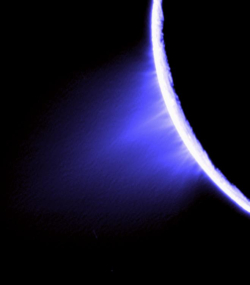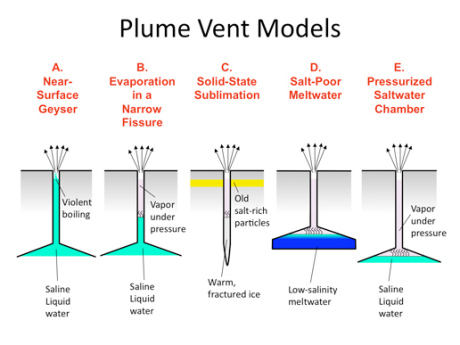This article is more than 1 year old
Salty Saturn moon plumes suggest stuff of life
Giant geysers project forth
Massive geysers on Saturn's moon Enceladus may be fed by a salty ocean beneath the surface, adding weight to speculation it harbors the essential building blocks needed for life.

Enceladian plumes, courtesy of NASA
Scientists working on NASA's Cassini mission have detected sodium salts in ice grains of Saturn's outermost ring. The planet's outer ring, or "E-ring," is believed to be primarily supplied by giant geysers on Enceladus's south polar region tossing out materials to a distance of three times the moon's radius. Cassini's cosmic dust analyzer has examined the composition of the material and found salt within it.
Since the discovery of Enceladus' eruptions in 2005, the tiny moon has become a top candidate for where extraterrestrial organic life could exist within our own solar system. Enceladus has at least two of the three requirements scientists are looking for: it's the proper warmth and has the necessary organic compounds. The final ingredient is liquid water, and continued analysis of the moon's geysers indicate the source is a sub-surface ocean of water.
"We believe that the salty minerals deep inside Enceladus washed out from rock at the bottom of a liquid layer," said Frank Postberg, Cassini scientist at the Max Planck Institute for Nuclear Physics in Heidelberg, Germany. Postberg is the lead author of a study that appears in the June 25 issue of Nature.
The scientists on Cassini's cosmic dust-watching team have concluded it must be liquid water lurking under the surface because it's the only way to dissolve the amount salt detected. They say the process of sublimation - where a compound transistions from solid to gas with no intermediate liquid stage - cannot account for the presence of salt.
"Potential plume sources on Enceladus are an active area of research with evidence continuing to converge on a possible salt water ocean," said Linda Spilker, Cassini deputy project scientist at NASA's Jet Propulsion Laboratory. "Our next opportunity to gather data on Enceladus will come during two flybys in November."
When Saturn's outermost ring grains were checked by the Cassini dust analyzer, nearly every time it found at least some sodium within the particles, the scientists said. The measurements also contained carbonates like soda, and both materials in concentrations that match the predicted composition of a underground Enceladus ocean.
However, a another study on ground-based observations did not detect traces of sodium on the geyser plumes of Enceladus themselves. Sodium combined with chloride are the two major components of salt.
The scientists believe the results mean if the plume vapor comes from an subterranean ocean, the evaporation must take place deep underground rather than a violent eruption near the surface similar to geysers found at Yellowstone National Park in Wyoming as previously thought.

How Enceladus' plumes may be formed - NASA/JPL/SWRI/University of Colorado
"Finding salt in the plume gives evidence for liquid water below the surface," said Sascha Kempf, a Cassini scientist on the dust analyzer team. "The lack of detection of sodium vapor in the plume gives hints about what the water reservoir might look like."
Further analysis of Enceladus eruptions will be a top priority for Cassini during the orbiter's extended tour of the neighborhood. ®
